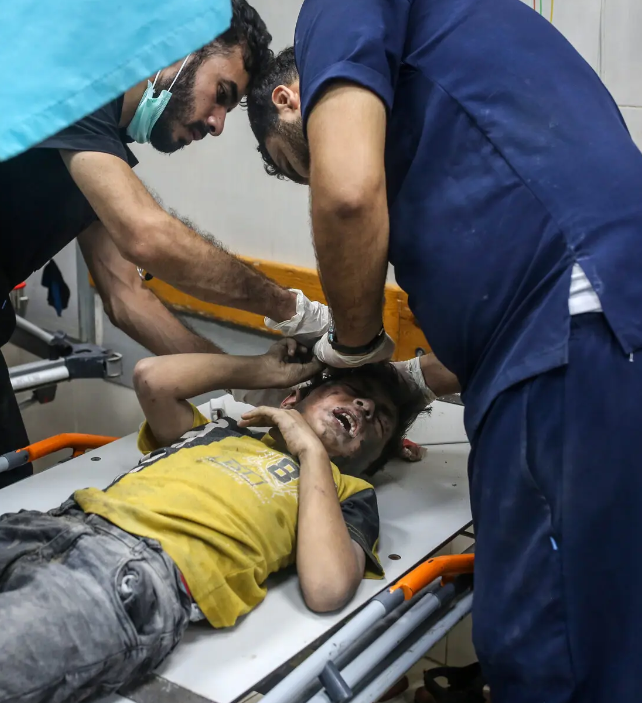5 October 2025
The full horror of the nearly three-year long Israeli military onslaught on Gaza, which has destroyed over 70 per cent of all medical facilities and some 95 per cent of housing, is set out in a new report on the plight of civilian victims in the BMJ (British Medical Journal. Here is an editorial on the report in the same publication.
Gaza: documenting the trauma of war
Collated descriptions of injuries illustrate the daunting challenges ahead
Derek Summerfield honorary senior clinical lecturer, King’s College London
Little is known about patterns of injury in civilians subjected to high intensity bombardments, such as those that occurred during the US and UK invasions of Iraq and Afghanistan and which are now occurring in Gaza. In Iraq, for example, according to Human Rights Watch, 29 000 bombs were dropped in only a few weeks in 2003.1 An observational study by Maitland and colleagues analysed 983 civilian blast and ballistic casualties in Afghanistan in order to generate what they said was the first evidence based assessment of injury burden, and a guide to the immediate medical responses required.2 The three most common surgical procedures for civilian blast injuries were debridement, amputation, and laparotomy; for civilian ballistic injuries, these were debridement, laparotomy, and vascular procedures.
In a linked study in The BMJ, El-Taji and colleagues have now gone much further (doi:10.1136/bmj-2025 087524).3 The authors draw on the first-hand experiencesof78healthcareworkersdeployedacross all five Gaza governorates and representing 22 non-governmental organisations. Two thirds of the workers had previous experience working in war zones, and most kept records or journals of the patients they saw while working in Gaza, which adds credibility to the details reported in this study.
Research of this kind is enormously difficult, especially since accurate record-keeping in conflict zones is often impossible, as when computer systems and paper records have been destroyed and medical facilities are overwhelmed by casualties. The reports of these front-line professionals provide systematic documentation of the patterns of injury currently overwhelming Gaza hospitals. A multifactorial methodology was applied to a dataset comprising nearly 24000 traumatic injuries documented by these professionals. Information not captured relate to those people who died on the spot or before they could be brought to a hospital.
As a field of study, Gaza has distinctive features that may influence the nature and pattern of injuries and deaths. In most of history, civilians have had some ability to flee active war zones but scarcely so in this case: Gaza is entirely enclosed. Its citizens are confined to a densely populated urban centre, and this study attests to the effects of high explosive and incendiary munitions driven down narrow urban corridors. Gazans have faced a military assault across the whole of society and its institutions, the intensity and scale of which, allied to telling statements of intent by Israeli leaders, led the International Court of Justice to conclude in January 2024 (only three months after onset) that this was a plausible case for genocide.4 Since then, an independent United Nations commission of enquiry, Amnesty International, Israeli human rights organisations B’Tselem and Physicians for Human Rights, and at least 52 sovereign states, have concluded similarly.5-7 Furthermore, adding to the extremity of the medical situation, Gazans confront famine as a weapon of war.8
Regarding the capacity of the health service to respond to these events, there has been systematic flouting of the Geneva Convention-conferred immunity afforded to medical facilities and staff. Hospitals have been flattened. In all war zones, rescuers wear clothing identifying them as healthcare professionals, which is supposed to guarantee protection but has made them targets here.910 According to Médicins sans Frontières (updated September2025),1500 health care professionals have been killed.11
As an example of the targeting of healthcare professionals—AdnanAl-Bursh, head of orthopaedics at Gaza’s largest hospital, Al-Shifa, was abducted from the hospital in December 2023, where he was reportedly working around the clock. He was 49 years old and in good health. His death was announced four months later, likely after torture.12 In July 2025, the Guardian reported that 28 Gazan doctors were currently under detention, of whom eight were senior consultants in surgery, orthopaedics, intensive care, cardiology, and paediatrics.13
The current study notes that injury profiles resemble those sustained in combat settings by military personnel, and that the healthcare workers in the survey perceived injury patterns to be more severe than those encountered in previous war zones. Multi-limb trauma, degloving injuries, open skull fractures, extensive visceral and vascular injuries were common, often presenting in unstable patients. Burns were reported by 70% of healthcare workers, and head trauma—including diffuse and penetrating injuries—by 73% of the healthcare workers. Workers reported 742 obstetric cases, of which 36% involved the death of a fetus, mother, or both. The authors have identified an injury phenotype among survivors comprising pervasive polytrauma, substantive trauma to head and extremities, fulminant blast and shrapnel wounds, and extensive burns.
Many other human stories unmask the horror behind the statistics. A 10-year-old girl is admitted with a shattered pelvis and femur, ruptured bladder, avulsed ureter, rectal injury, and torn femoral and external iliac arteries. She dies in pain several hours later. There are no anaesthetics or sterile materials, operations take place on emergency department floors, and malnutrition worsens outcomes and delays wound healing. No cancer treatment is available. Children are rendered suicidal after witnessing the traumatic deaths of family members.
The collated descriptions of the extent and distribution of traumatic injuries, including burns, graphically illustrate the daunting challenges ahead. The study by El-Taji and colleagues adds substantially to our understanding of the scale and nature of civilian suffering in conditions of war without restraint. It illuminates both the tasks facing medical relief and surgery in the acute phase, and the nature of the immense surgical and medical rehabilitation that will have to follow for survivors. It is likely to prove a landmark study.
Competing interests: The BMJ has judged that there are no disqualifying financial ties to commercial companies. The authors declare the following other interests: None.
1. Human Rights Watch. Conduct of the air war. 2003. https://www.hrw.org/re ports/2003/usa1203/4.htm
2. Maitland L, Middleton L, Veen H, Harrison DJ, Baden J, Hettiaratchy S. Analysis of 983 civilian blast and ballistic casualties and the generation of a template of injury burden: An observational study. EClinical Medicine 2022;54:101676. doi: 10.1016/j.eclinm.2022.101676. pmid: 36204004
3. El-Taji O, Ali A, Alser O, et al. Patterns of war related trauma in Gaza during armed conflict: survey study of international healthcare workers. BMJ 2025;390:e087524. doi: 10.1136/bmj-2025-087524.
4. Skander GalandA, Muller W. The ICJ’s Findings on Plausible Genocide in Gaza and its Implications for the International Criminal Court. Opinio Juris 2024. https://opiniojuris.org/2024/04/05/the icjs-findings-on-plausible-genocide-in-gaza-and-its-implications-for-the-international-criminal court/
5. UN Office of the High Commissioner for Human Rights. Israel has committed genocide in the GazaStrip, UN Commission finds.2025.https://www.ohchr.org/en/press-releases/2025/09/israel has-committed-genocide-gaza-strip-un-commission-finds
6. Amnesty International. Amnesty International investigation concludes Israel is committing genocide against Palestinians in Gaza. 2024. https://www.amnesty.org/en/latest/news/2024/12/amnesty international-concludes-israel-is-committing-genocide-against-palestinians-in-gaza/
7. Amnesty International. Israel/OPT: Israeli organizations conclude Israel committing genocide against Palestinians in Gaza in another milestone for accountability efforts. 2025. https://www.amnesty.org/en/latest/news/2025/07/israel-opt-israeli-organizations-conclude-israel committing-genocide-against-palestinians-in-gaza-in-another-milestone-for-accountability-efforts/
8. World Health Organization. Famine confirmed for first time in Gaza. 2025. https://www.who.int/news/item/22-08-2025-famine-confirmed-for-first-time-in-gaza
9.Hall R. ‘Healthocide’: experts warn of rise in targeting of health services in conflict. The Guardian 2025.https://www.theguardian.com/world/2025/aug/05/healthocide-doctors-hospitals-targeted gaza
10. Al-Haq. Submission to the UN Special Rapporteur on the Right to Health: Israel’s targeting of Palestinian Healthcare Workers, An Act of Genocide. 2025. https://www.alhaq.org/advoca cy/26620.html
11. Medecins Sans Frontieres. Remembering our colleagues killed in Gaza. 2024. https://www.doc torswithoutborders.org/latest/remembering-our-colleagues-killed-gaza
12. UN Office of the High Commissioner for Human Rights. UN expert horrified by death of Gazan orthopedic surgeon in Israeli detention. 2024. https://www.ohchr.org/en/press-releas es/2024/05/un-expert-horrified-death-gazan-orthopedic-surgeon-israeli-detention
13. Kelly A, Osman H. Rising number of doctors among hundreds of medical staff detained in Gaza, say rights groups. The Guardian 2025. https://www.theguardian.com/global-develop ment/2025/jul/26/rising-number-of-doctors-among-hundreds-of-medical-staff-detained-in-gaza say-rights-groups











